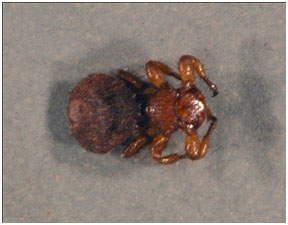Sheep Keds
A quick review of the blood sucking little thieves!
The sheep ked, Malophagus ovinus, is often referred to as the sheep tick. It is an external parasite of sheep that will spend its entire life cycle on the sheep. While it resembles a tick, it is actually a wingless fly. It can be found all over the world and at any time of the year.

Figure 1: Sheep Ked
This blood sucking parasite will cause inflammation and damage to the sheep at the site of the bite. Infested sheep will often scratch and bite to relieve the “itch”; which in turn causes wool tags and/or loss of wool. Their excrement causes wool staining also reducing the quality of the wool clip. These critters cause damage to the pelt; referred to as “cockle”; which is a blemish to and decrease in the strength of the leather produced.
The adult ked will live for 3-4 months. During this time the female will produce eggs which are retained in her uterus until she extrudes a mature larva. This happens at the rate of 1 every 7 or 8 days. The larvae will then pupate; this stage of the ked is usually found on the underside of the abdomen and shoulder region where it is attached to the sheep with a sticky substance; insecticides do not work on this stage of the ked. From here they will develop into a mature ked in the next 3-5 weeks depending upon the environmental temperatures.

Figure 2: Hide damage due to sheep keds.
Keds can be readily seen by parting the wool. When checking for keds look over the shoulders, neck, chest or rump areas. Shearing will remove some of the pupae and adult keds. Treatment for and control of keds is best accomplished at this time due to better coverage and distribution of the insecticide on the sheep. When shearing is performed prior to lambing it will also reduce the spread of keds to the lambs. This is especially important to prevent anemia in young lambs. Dips, sprays, spot-ons and pour-ons are all effective means of treatment. Oil base products have a longer duration of effectiveness but tend to attract dirt in the wool. Permethrines, coumaphos, fenvalerate and lindanes are pesticides which are effective on both keds and lice. Make sure and read all labels for correct dilution and application rates of the product you choose.
Prepared by Gerilyn A. Parsons, Cleon V. Kimberling, Jay Parsons, and
Wayne Cunningham
Optimal Livestock Services, LLC
970-231-2477
Copyright © 2011 CleonsCorner.com All Rights Reserved
